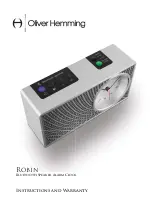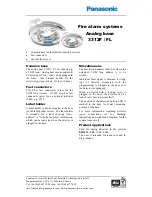
SPECIFICATIONS:
Detection Type:
Photoelectric Chamber
Power Source:
Built-in DC3V (CR123A) Lithium battery
(Non-replaceable battery)
Standby Current
<8uA
Alarm Current
<70mA
Alarm Sound Level
>85dB at 3 metres
Alarm Sensitivity
0.09 - 0.15dB/m
Hush Time
Approx. 10 mins
Operation Temperature
5°C to 45°C
Ambient Humidity
up to 85%
Sound Pattern:
ISO8201(BI0.5s - pause 0.5s - BI 0.5s - pause
0.5s - BI 0.5s - pause 1.5s, with the red LED
flash, repeat this alarm pattern).
Compliance Standard
AS3786:2014
The unit is a photoelectric 3V DC smoke alarm.
Photoelectric technology is more sensitive to
detecting slow smouldering fires which are
generally thick with black smoke, little heat and
may smoulder for hours before bursting into
flames. This smoke alarm does not contain
radioactive material.
IMPORTANT:
This manual contains important
information about the installation and operation of
your smoke alarm. Please read carefully before
installation and keep for future reference. Please
ensure that this leaflet remains in the household
where the alarm is installed.
WARNING:
This smoke alarm is designed to alert
you to the presence of smoke. It cannot prevent a
fire. There are hazards against which smoke
alarms may not be effective such as smoking in
bed, explosions, etc. The ultimate responsibility
for fire protection rests with you. This
responsibility includes escape planning, safety
checks and an effective warning system. In case
of fire, a well placed, properly looked after smoke
alarm may provide a few seconds so that you can
escape and call the fire brigade.
IMPORTANT SAFETY INFORMATION
1. This smoke alarm has an inbuilt Lithium battery
that does not require servicing or changing. This
battery is a 10 year maintenance free battery that
is not accessible to the user. This battery must be
operational to operate the alarm correctly. To test
the battery press the test button on this
smoke alarm.
2.
DO NOT
connect this smoke alarm to any
other type of smoke alarm The test button
accurately tests all smoke alarm functions.
3. The Test button accurately tests all smoke
alarm functions.
DO NOT
use any other test
method. Test smoke alarm weekly to ensure
proper operation.
4.
DO NOT
remove or disconnect battery to
silence unwanted alarms. This will remove your
protection. Use the Hush Feature, open windows
or ventilate the smoke alarm to silence it.
5. This smoke alarm may be installed by a
licensed, qualified electrician or a competent
individual. Observe and follow all local and
national electrical and building codes for
installation.
6. This smoke alarm is designed to be used
inside a single unit dwelling only. In buildings with
several dwellings, each individual living unit
should have its own smoke alarms.
DO NOT
install in non-residential buildings. This smoke
alarm is not a substitute for a complete alarm
system.
7. Install a smoke alarm in every room and on
every level of the home. Smoke may not reach the
smoke alarm for many reasons. For example, if a
fire starts in a remote part of the home, on another
level, in a chimney, wall, roof or on the other side
of a closed door. Smoke may not reach the smoke
alarm in time to alert household members. A
smoke alarm will not promptly detect a fire except
in the area or room in which it is installed.
8. Smoke alarms may not alert every household
member every time. The alarm sound is loud in
order to alert individuals to a potential danger.
However, there may be limiting circumstances
where a household member may not hear the
alarm (i.e. outdoor or indoor noise, sound
sleepers, drug or alcohol usage, hard of hearing,
etc.). If you suspect that this smoke alarm may not
alert household members, install and maintain
specialty alarms. Household members must hear
the alarm’s warning sound and respond, to quickly
reduce the risk of damage, injury or death that
may result from fire. If a household member is
hearing impaired, install special smoke alarms
with lights or vibrating devices to alert occupants.
9. Smoke alarms can only sound their alarms
when they detect smoke. Smoke alarms detect
combustion particles in the air. They do not sense
heat, flame or gas. This smoke alarm is designed
to give an audible warning of a developing fire.
However, many fires are fast burning, explosive or
intentional. Others are caused by carelessness or
safety hazards. Smoke may not reach the smoke
alarm quickly enough to ensure safe escape.
10. Smoke alarms have limitations. This smoke
alarm is not foolproof and is not warranted to
protect lives or property from fire. Smoke alarms
are not a substitute for insurance. Homeowners
and renters should insure their lives and property.
In addition, it is possible for the smoke alarm to fail
at any time. For this reason, you must test the
smoke alarm weekly and replace every 10 years.
NOTE:
For best protection, we recommend that
you install a smoke alarm in every room.
WHERE TO INSTALL YOUR ALARM
For best safety, install smoke alarms in every
room: Including hallways, bedrooms, living
rooms, attics & basement. At the very least, one
smoke alarm on every floor.
SMOKE ALARM PLACEMENT
Typical single-storey home
Install a smoke alarm on the ceiling or wall inside
each bedroom and in the hallway outside each
separate sleeping area. If a bedroom area or
hallway is more than 9 metres (30 feet) long,
install a smoke alarm at each end. If there is a
basement, install a smoke alarm on the basement
ceiling at the bottom of the stairwell.
Typical Multi-storey or split level home
Install a smoke alarm on the ceiling or wall inside
each bedroom and in the hallway outside each
separate sleeping area. If a bedroom area or
hallway is more than 9 metres (30ft) long, install a
smoke alarm at each end. Please install a smoke
alarm on the top of a first-to-second floor stairwell.
RECOMMENDED PLACEMENT OF SMOKE
ALARMS
Locate a smoke alarm in any area where a smoker
sleeps or where electrical appliances are operated
in sleeping areas.
Smoke, heat and other combustion products rise
to the ceiling and spread horizontally. Mounting
the smoke alarm on the ceiling in the centre of the
room places it closest to all the points in the room.
Ceiling mounting is preferred in ordinary
residential construction. However, in mobile
homes, wall mounting on an inside partition is
preferred to avoid the thermal barrier that may
form in the ceiling.
AS3786:2014
Lic SMKH25550
SAI Global
BEDROOM
HALL
BEDROOM
LIVING ROOM
KITCHEN
BASEMENT
MULTI-STOREY RESIDENCE
KEY:
Minimum required smoke alarm locations
Recommended additional smoke alarm locations
Smoke alarms with hush features recommended
for additional protection
Heat and
smoke
from fire
Best here
Dead air space,
do not install here
300mm
minimum
300mm minimum
Dead air space,
do not install here
900mm
minimum
Best here
FFPDCH10Y
PHOTOELECTRIC SMOKE ALARM WITH
10 YEAR LITHIUM BATTERY
TEST & HUSH BUTTON
DINING ROOM
LIVING ROOM
BEDROOM
BEDROOM
KITCHEN
SINGLE-STOREY RESIDENCE, APARTMENT, MOBILE HOME





















